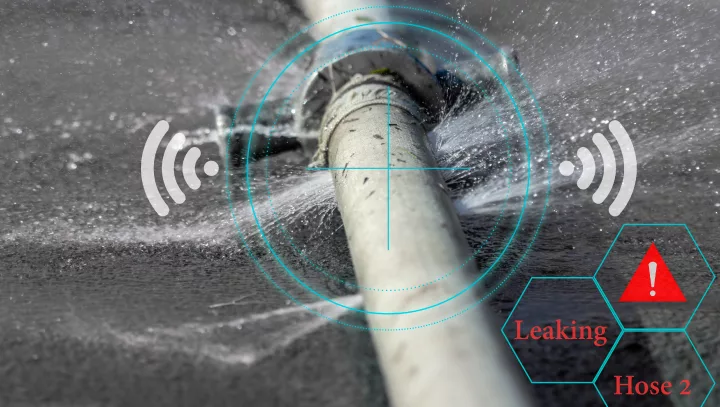Why Timely Water Leak Detection is Important for Keeping a Healthy Home
Why Timely Water Leak Detection is Important for Keeping a Healthy Home
Blog Article
Innovative Solutions for Early Detection of Water Leakages in Buildings and Facilities
From sophisticated leakage detection modern technologies to the release of IoT sensing units for real-time tracking, the landscape of leakage prevention is developing swiftly. Automated water flow analysis systems are reshaping exactly how leaks are determined and dealt with, paving the means for a proactive approach to water leak detection.
Advanced Leakage Detection Technologies
Advanced leakage detection innovations, equipped with advanced sensors and algorithms, play a vital role in swiftly recognizing and determining water leakages in various setups. These technologies utilize a mix of acoustic, thermal, and electro-magnetic noticing techniques to detect leaks properly. Acoustic sensors identify the audio of getting away water, enabling specific localization of the leak source. Thermal imaging identifies temperature level modifications triggered by water leak, offering another efficient technique for leak identification. Electro-magnetic sensors can recognize modifications in magnetic fields triggered by water, supplying yet one more layer of leak discovery ability.

IoT Sensors for Real-Time Monitoring
In the realm of modern-day water leak detection, the integration of IoT sensors for real-time surveillance stands for a crucial improvement in boosting proactive leak discovery capacities. These sensing units offer continuous tracking of water supply, offering real-time information on water circulation prices, pressure variants, and temperature level modifications. By leveraging IoT modern technology, these sensing units can spot even the smallest abnormalities in water usage patterns, enabling early identification of prospective leakages prior to they rise right into significant issues.
IoT sensors send information to a central platform, where sophisticated formulas analyze the info and generate notifies or notifications when abnormalities are detected. This real-time surveillance capacity allows homeowner or facility managers to immediately resolve leakages, decreasing water damages, reducing repair expenses, and saving water sources.
Additionally, IoT sensors can be incorporated with building monitoring systems, permitting automatic feedbacks to spotted leakages, such as turning off water valves or activating pumps to mitigate the effect of leaks. On the whole, the implementation of IoT sensors for real-time surveillance dramatically enhances the performance and performance of water leakage detection in buildings and facilities.
Machine Knowing Algorithms for Leak Prediction

One secret benefit of utilizing maker understanding for leakage prediction is its ability to continually find out and boost its precision gradually. As more data is accumulated and fed right into the formula, it can improve its predictions and adjust to changing conditions, inevitably increasing the integrity of leakage discovery systems.
Additionally, artificial intelligence browse around this web-site formulas can help in identifying refined signs of leaks that may go unnoticed by traditional surveillance approaches. water leak detection. By analyzing complicated data embed in real-time, these algorithms can supply very early warnings and alerts, enabling for prompt treatment and precautionary maintenance to minimize prospective water damages and linked expenses
Using Thermal Imaging for Leak Detection
Thermal imaging technology provides an encouraging method for spotting water leakages in numerous systems and infrastructures. By making use of infrared radiation and temperature level linked here variances, thermal imaging electronic cameras can determine covert leaks that are not conveniently visible to the nude eye. When water leaves from pipes or structures, it often changes the temperature of the surrounding location, creating temperature differentials that thermal electronic cameras can record. These temperature irregularities are then converted right into visible images, highlighting the precise location of the leakage.
Among the essential advantages of thermal imaging for leak discovery is its non-intrusive nature. Unlike standard techniques that may need getting into walls or floorings to find leaks, thermal imaging allows for non-destructive testing. This not only conserves time and decreases costs yet additionally lessens disruption to the building or infrastructure being evaluated. In addition, thermal imaging can quickly scan large locations, supplying an extensive summary of possible leakage sources in a prompt fashion. In general, making use of thermal imaging innovation boosts the effectiveness and accuracy of water leakage discovery, making it an important tool for keeping the stability of structures and infrastructures.
Automated Water Circulation Evaluation Systems
How can automated water flow analysis systems revolutionize the detection and management of leaks in various systems and infrastructures? Automated water circulation analysis systems offer a proactive technique to leak detection by constantly keeping track of water flow rates and patterns. By developing standard information, these systems can quickly recognize discrepancies that might suggest a leak, enabling timely intervention to stop considerable damages.
These systems use sophisticated algorithms to evaluate real-time data and offer immediate signals when abnormalities are spotted, allowing for quick action to be taken. Furthermore, automatic water circulation evaluation systems can be incorporated with building monitoring systems or IoT systems, boosting overall performance and making it possible for remote monitoring abilities.
Additionally, the information gathered by these systems can be utilized for predictive upkeep purposes, helping to identify prospective powerlessness in the framework before leakages take place. In general, the execution why not look here of automated water flow evaluation systems can dramatically improve leakage detection and monitoring practices, ultimately bring about set you back savings, minimized water wastage, and raised sustainability in buildings and facilities.

Conclusion
In conclusion, the combination of sophisticated leak discovery modern technologies, IoT sensing units, artificial intelligence formulas, thermal imaging, and automatic water flow evaluation systems offers ingenious options for early discovery of water leaks in structures and infrastructure. These technologies enable real-time monitoring, forecast of leakages, and effective discovery techniques to prevent water damages and waste. Implementing these services can help in preserving the integrity and sustainability of water supply in various setups.
Report this page